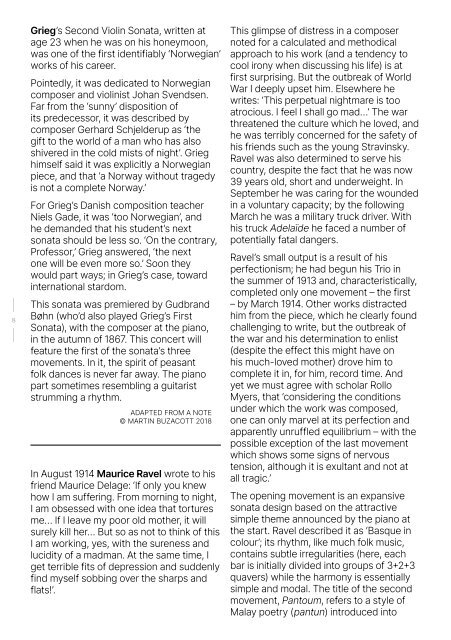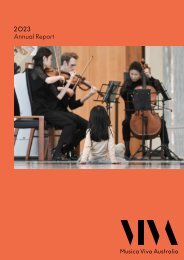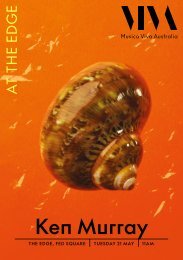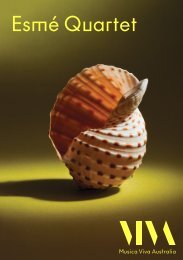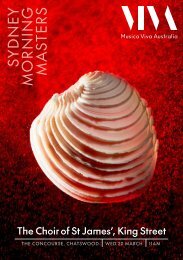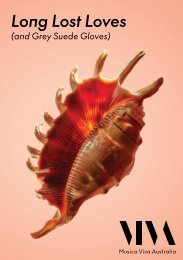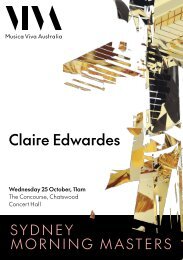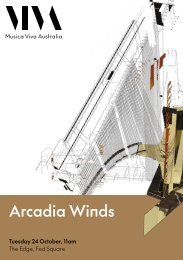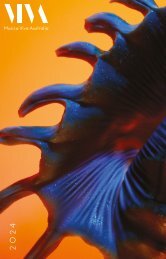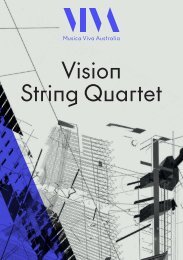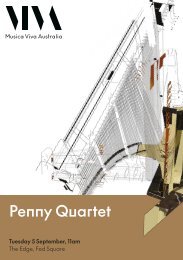Bernadette Harvey, Harry Bennetts & Miles Mullin-Chivers Program Guide | February 2022
Create successful ePaper yourself
Turn your PDF publications into a flip-book with our unique Google optimized e-Paper software.
|<br />
8<br />
|<br />
Grieg’s Second Violin Sonata, written at<br />
age 23 when he was on his honeymoon,<br />
was one of the first identifiably ‘Norwegian’<br />
works of his career.<br />
Pointedly, it was dedicated to Norwegian<br />
composer and violinist Johan Svendsen.<br />
Far from the ‘sunny’ disposition of<br />
its predecessor, it was described by<br />
composer Gerhard Schjelderup as ‘the<br />
gift to the world of a man who has also<br />
shivered in the cold mists of night’. Grieg<br />
himself said it was explicitly a Norwegian<br />
piece, and that ‘a Norway without tragedy<br />
is not a complete Norway.’<br />
For Grieg’s Danish composition teacher<br />
Niels Gade, it was ‘too Norwegian’, and<br />
he demanded that his student’s next<br />
sonata should be less so. ‘On the contrary,<br />
Professor,’ Grieg answered, ‘the next<br />
one will be even more so.’ Soon they<br />
would part ways; in Grieg’s case, toward<br />
international stardom.<br />
This sonata was premiered by Gudbrand<br />
Bøhn (who’d also played Grieg’s First<br />
Sonata), with the composer at the piano,<br />
in the autumn of 1867. This concert will<br />
feature the first of the sonata’s three<br />
movements. In it, the spirit of peasant<br />
folk dances is never far away. The piano<br />
part sometimes resembling a guitarist<br />
strumming a rhythm.<br />
ADAPTED FROM A NOTE<br />
© MARTIN BUZACOTT 2018<br />
In August 1914 Maurice Ravel wrote to his<br />
friend Maurice Delage: ‘If only you knew<br />
how I am suffering. From morning to night,<br />
I am obsessed with one idea that tortures<br />
me… If I leave my poor old mother, it will<br />
surely kill her… But so as not to think of this<br />
I am working, yes, with the sureness and<br />
lucidity of a madman. At the same time, I<br />
get terrible fits of depression and suddenly<br />
find myself sobbing over the sharps and<br />
flats!’.<br />
This glimpse of distress in a composer<br />
noted for a calculated and methodical<br />
approach to his work (and a tendency to<br />
cool irony when discussing his life) is at<br />
first surprising. But the outbreak of World<br />
War I deeply upset him. Elsewhere he<br />
writes: ‘This perpetual nightmare is too<br />
atrocious. I feel I shall go mad…’ The war<br />
threatened the culture which he loved, and<br />
he was terribly concerned for the safety of<br />
his friends such as the young Stravinsky.<br />
Ravel was also determined to serve his<br />
country, despite the fact that he was now<br />
39 years old, short and underweight. In<br />
September he was caring for the wounded<br />
in a voluntary capacity; by the following<br />
March he was a military truck driver. With<br />
his truck Adelaïde he faced a number of<br />
potentially fatal dangers.<br />
Ravel’s small output is a result of his<br />
perfectionism; he had begun his Trio in<br />
the summer of 1913 and, characteristically,<br />
completed only one movement – the first<br />
– by March 1914. Other works distracted<br />
him from the piece, which he clearly found<br />
challenging to write, but the outbreak of<br />
the war and his determination to enlist<br />
(despite the effect this might have on<br />
his much-loved mother) drove him to<br />
complete it in, for him, record time. And<br />
yet we must agree with scholar Rollo<br />
Myers, that ‘considering the conditions<br />
under which the work was composed,<br />
one can only marvel at its perfection and<br />
apparently unruffled equilibrium – with the<br />
possible exception of the last movement<br />
which shows some signs of nervous<br />
tension, although it is exultant and not at<br />
all tragic.’<br />
The opening movement is an expansive<br />
sonata design based on the attractive<br />
simple theme announced by the piano at<br />
the start. Ravel described it as ‘Basque in<br />
colour’; its rhythm, like much folk music,<br />
contains subtle irregularities (here, each<br />
bar is initially divided into groups of 3+2+3<br />
quavers) while the harmony is essentially<br />
simple and modal. The title of the second<br />
movement, Pantoum, refers to a style of<br />
Malay poetry (pantun) introduced into


